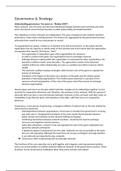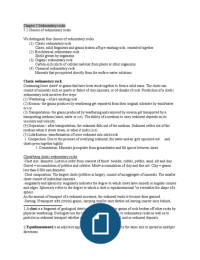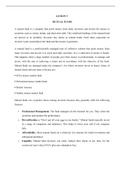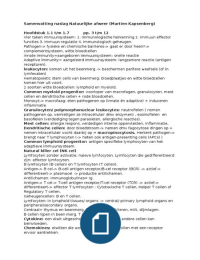Governance & Strategy
Understanding governance: Ten years on – Rhodes (2007)
Policy network: sets of formal and informal institutional linkages between governmental and other
actors structured around shared interests in public policymaking and implementation.
The institutions in these networks are independent. The actors included are the network members,
professions, trade unions and big business. The interest are aggregated by the government because
otherwise there would be too many groups to consult.
‘An organization has power, relative to an element of its task environment, to the extent that the
organization has the capacity to satisfy needs of that element and to the extent that the organization
monopolises that capacity’ (Thompson, 1967)
- Any organisation is dependent upon other organisations for resources
- In order to achieve their goals, the organisations have to exchange resources
- Although decision-making within the organisation is constrained by other organisations, the
dominant coalition retains some discretion. The appreciative system of the dominant
coalition influences which relationships are seen as a problem and which resources will be
sought
- The dominant coalition employs strategies within known rules of the game to regulate the
process of exchange
- Variations in the degree of discretion are a product of the goals and the relative power
potential of interacting organisations. This relative power potential is a product of the
resources of each organisation, of the rules of the game and of the process of exchange
between organisations
Shared values and norms are the glue which holds the complex set of relationships together; trust is
essential for cooperative behaviour and, therefore, the existence of the network. With the spread of
networks there has been a recurrent tension between contracts on the one hand, with their stress on
competition to get the best price, and networks on the other, with their stress on cooperative
behaviour.
Governance: a new process of governing, a changed condition of ordered rule or the new method by
which society is governed.
- Interdependence between organizations. Governance is broader than government, covering
non-state actors. Changing the boundaries of the state meant the boundaries between
public, private and voluntary sectors became shifting and opaque.
- Continuing interactions between network members, caused by the need to exchange
resources and negotiate shared purposes.
- Game-like interactions, rooted in trust and regulated by rules of the game negotiated and
agreed by network participants.
- A significant degree of autonomy from the state. Networks are not accountable to the state;
they are self-organizing. Although the state does not occupy a privileged, sovereign position,
it can indirectly and imperfectly steer networks.
Governance refers to governing with and through networks.
The functions of the core executive are to pull together and integrate central government policies
and to act as final arbiters of conflicts between different elements of the government machine. These
functions can be carried out by institutions other than prime minister and cabinet.
,The positional approach assumes that power lies with specific positions and the people who occupy
those positions. But power is contingent and relational; that is, it depends on the relative power of
other actors. This power-dependence approach focuses on the distribution of such resources as
money and authority in the core executive and explores the shifting patterns of dependence
between the several actors.
“Hollowing out of the state” means that the growth of governance reduced the ability of the core
executive to act effectively, making it less reliant on a command operating code and more reliant on
diplomacy. The state can be hollowed out from above (e.g. international interdependence), from
below (e.g. marketization and networks) and sideways (e.g. agencies and parastatal bodies).
Governance in operating room nursing: Nurses’ knowledge of individual surgeons – Riley & Manias
(2006)
Operating room nurses are perceived in different ways. On the one hand, this profession is perceived
as attractive because of the close association nurses have with surgeons, the teamwork and the
highly technical work. On the other hand, this profession is devalued from the wider profession
because the nurses are often conceptualised as handmaidens. Originally, the image of handmaiden
was considered a sign of prestige. Being in close contact with surgeons was seen as a privilege.
Nurses derived power from their close association with doctors. Recently, the image of handmaiden
has been seen as derogative and patriarchal.
Several implications can be drawn from the handmaiden image, centring on the idea that nurses’
bodies and knowledge are the site for discursive control by others. First, the handmaiden image
emphasises manual work and the handing of instruments to surgeons during surgery where
knowledge is centred mostly on bodily, task orientated skills and manual dexterity. This notion seems
to imply that there are limitations about the type of knowledge that nurses have access to and use in
their practice and that this manual work and bodily knowledge are insufficient to be of real worth in
the production of nursing practice. Second, operating room nurses are depicted as having a uni-
dimensional subjectivity, where other subject positions are made invisible or downplayed in
comparison to this dominant image. Third, the handmaiden image implies that the body of the
operating room nurse is the site of discursive control by others, in which nurses cater to the whims
and needs of surgeons and are accountable to and respond to their command in clinical practice,
rather than their nursing colleagues and managers. In doing so, the work of nurses is belittled and
devalued by displacing nurses’ own priorities.
The problematic identity of operating room nursing has been further complicated by nurses’ lack of
connectedness and interpersonal communication with patients. The relationship between nurses and
patients shifted from being mechanistic and passive to subjective and caring. Dominant discourses
of care in nursing depicted care as a subjective and relational concept, dependant on interpersonal
exchanges, connection and communication with the patients so as to understand their holistic
experiences. From the operating room nurses’ perspective, providing a relational form of care to
patients comes with conceptual difficulty. The focus of operating room nurses’ attention is on the
bodies of patients. There is no possibility of conscious interaction during surgery. This distances
operating room nurses from the broader domain of nursing. This image of operating room nurses has
also been fostered through an invisibility of their nursing practice because it occurs in the backstage
areas of the hospital. This prohibits understanding the work of these nurses and what happens within
these areas.
Operating room nurses have historically been constructed as subservient handmaidens
to surgeons, lacking governance and control of their own work environment. This occupational
identity has been fostered through operating room nurses’ close physical proximity to surgeons and a
separation of the specialty from the broader profession of nursing. Stereotypical media images and
,the invisibility of practice in this setting have undoubtedly contributed to the perceptions about
operating room nurses and their work.
They are techniques of governmentality through which nurses exercised power
to shape and control practice. That is, through having knowledge of individual surgeons, operating
room nurses were active social agents in governing their practice and subjectivity. Participants
provided accounts of how they constructed themselves as gatekeepers, as ‘‘super nurses’’, as
peacekeepers, and as timekeepers. They engaged in self-mastery and self-authorising practices that
shaped communication interactions and governance in operating rooms, to actively shape ‘‘the
conduct of conduct’’, and ‘‘evincing a concern for every individual and the population as a whole’’.
Nurses’ personal knowledge of surgeons is not generalizable or transferable to other institutions. It
is highly contextual knowledge played out at the micro level of practice and limited to the institution
on which the surgeons worked. As experiential knowledge, it differentiated between beginning and
expert operating room nurses, placing them in a hierarchy according to the extent to which they
knew the various surgeons with whom they worked. Accordingly, nurses personal knowledge of
individual surgeons can be considered a ‘‘naıve’’ form of knowledge ‘‘located low down on the
hierarchy’’ which has been subjugated by more dominant forms through the exercise of power.
The backstage area of operating rooms allows for relationships between people of different
hierarchical positions, such as nurses and doctors, to develop in a way that transcends traditional
boundaries. The so-called ‘‘social’’ relationship between nurses and doctors in operating rooms
would be considered unconventional in more publicly visible areas, such as the hospital wards.
Structuring ambiguity in hospital governance – Scholten et al. (2018)
Hospital governance: a set of processes and tools related to decision making in steering the totality
of institutional activity, influencing most major aspects of organizational behaviour, and recognizing
the complex relationships between multiple stakeholders.
Hospital governance is a complex problem because of two intertwining dynamics:
1. Internal dynamics are rooted in the character of hospital organization as a professional
organization—consisting of several interdependent but relatively autonomous groups—
meeting the challenge to create workable and viable relations.
There are four groups (doctors, nurses, managers and supervisors) representing the
community, all contributing in their own specific way to hospital governance. Dual hospital
governance, the coexistence of managerial and professional lines of authority, can be
understood as a characteristic feature of hospital governance. In hospitals, decision making is
not rooted in a single “governance chain.” Particularly, traditional decision making in
hospitals depends on consensus management by permanent consultations and negotiations
between fundamentally different governance systems, each with its specific “institutional
logic.” Decision making by management is built on hierarchy whereas doctors furnish some
of their colleagues with responsibility by giving them mandate. Their governance systems
differ fundamentally as managers practice top ‐down decision making whereas doctors down decision making whereas doctors
typically take decisions bottom‐down decision making whereas doctors up. The challenge of hospital governance is rooted in the
“peaceful coexistence” of the two governance structures and, eventually, the integration of
decision‐down decision making whereas doctors making processes in the hospital.
2. The external dynamics of hospital governance result from governments and stakeholders'
pressure to change hospital governance. Hospital governance is a matter not only of
consulting and negotiating managers and doctors but also of the power of actors who act on
different societal levels. Governments explicitly exercise power to radically transform
hospital structure, which makes designing hospital governance arrangements essentially a
triadic affair of doctors, management, and government. Many governments seek to create
, and empower general management in hospitals as a way to improve governability in the
changing context of market‐down decision making whereas doctors oriented reform. They intend to change hospital governance
fundamentally by regulation, although changing governance relations can also be the
consequence of less direct interventions, for instance, performance management.
Governability: the overall capacity for governance of the hospital. Governability is expected to
improve by putting management of hospitals unambiguously in the hands of professional managers,
wishing to get rid of the arena‐down decision making whereas doctors like hospital governance system coupled with slow negotiating
processes of autonomous parties.
- Hospital management and medical specialists embrace duality as a fact of (hospital) life
followed by the contention to organize mutual dependence at hospital level and unit level.
This fundamental choice can be analysed as “pragmatic collaboration” in which the actors
search for workable and viable relationships, at odds with the monolithic hospital structure's
positioning of general management prescribed by governmental regulation.
- Hospital management and doctors organize duality by structuring relevant positions in the
decision‐down decision making whereas doctors making system of the hospital. These positions can be identified as boundary ‐down decision making whereas doctors
spanning positions granting the incumbents much discretion to fulfil their two conflicting
roles of representative and partner.
- Actors choose to keep formalization by rules and job descriptions low. Official documents
describe only the tasks and responsibilities in a generalized way. Instead, unwritten but
strongly felt norms of mutual understanding control behaviour. Respondents express the
relevance of behavioural norms and trust in controlling behaviour. As specifications and rules
are lacking, trust—defined as the mechanism that mediates interaction in situations of
unpredictable role behaviour—is indispensable for decision ‐down decision making whereas doctors making quality. In this sense,
trust is a functional equivalent for the exercise of power in role conflict when systematically
defined roles are absent and actors have to negotiate their mutual binding norms.
- Ambiguous positions ask for strong people. The positioning of doctors and managers at both
levels implies the introduction of role conflict combining the role of partner with the role of
representative of a party of doctors. The role of representative is especially difficult because
of the important process of generating commitment within the rank and file. To accomplish
role conflict, motivated and capable people are needed. Personal competencies and
characteristics are very relevant in this hospital governance system. However, dependence
on personal competencies and characteristics causes vulnerability of the decision-making
arrangement as institutions.
Developments in intergovernmental relations: towards multi-level governance – Peters & Pierre
(2001)
Multi-level governance: negotiated, non-hierarchical exchanges between institutions at the
transnational, national, regional and local levels. Multi-level governance refers not just to negotiated
relationships between institutions at different institutional levels but to a vertical ‘layering’ of
governance processes at these different levels. institutional relationships do not have to operate
through intermediary levels but can take place directly between, say, the transnational and regional
levels, thus bypassing the state level.
The linkage between policy change and institutional change works both ways: policy changes trigger
or necessitate institutional changes and, similarly, institutional changes frequently entail some
degree of policy change. In the present context, decentralisation and European integration have
jointly reshuffled institutional relationships and created a system where institutions at one level can
enter into exchanges with institutions at any other level and where the nature of the exchange is
characterised more by dialogue and negotiation than command and control.
Understanding governance: Ten years on – Rhodes (2007)
Policy network: sets of formal and informal institutional linkages between governmental and other
actors structured around shared interests in public policymaking and implementation.
The institutions in these networks are independent. The actors included are the network members,
professions, trade unions and big business. The interest are aggregated by the government because
otherwise there would be too many groups to consult.
‘An organization has power, relative to an element of its task environment, to the extent that the
organization has the capacity to satisfy needs of that element and to the extent that the organization
monopolises that capacity’ (Thompson, 1967)
- Any organisation is dependent upon other organisations for resources
- In order to achieve their goals, the organisations have to exchange resources
- Although decision-making within the organisation is constrained by other organisations, the
dominant coalition retains some discretion. The appreciative system of the dominant
coalition influences which relationships are seen as a problem and which resources will be
sought
- The dominant coalition employs strategies within known rules of the game to regulate the
process of exchange
- Variations in the degree of discretion are a product of the goals and the relative power
potential of interacting organisations. This relative power potential is a product of the
resources of each organisation, of the rules of the game and of the process of exchange
between organisations
Shared values and norms are the glue which holds the complex set of relationships together; trust is
essential for cooperative behaviour and, therefore, the existence of the network. With the spread of
networks there has been a recurrent tension between contracts on the one hand, with their stress on
competition to get the best price, and networks on the other, with their stress on cooperative
behaviour.
Governance: a new process of governing, a changed condition of ordered rule or the new method by
which society is governed.
- Interdependence between organizations. Governance is broader than government, covering
non-state actors. Changing the boundaries of the state meant the boundaries between
public, private and voluntary sectors became shifting and opaque.
- Continuing interactions between network members, caused by the need to exchange
resources and negotiate shared purposes.
- Game-like interactions, rooted in trust and regulated by rules of the game negotiated and
agreed by network participants.
- A significant degree of autonomy from the state. Networks are not accountable to the state;
they are self-organizing. Although the state does not occupy a privileged, sovereign position,
it can indirectly and imperfectly steer networks.
Governance refers to governing with and through networks.
The functions of the core executive are to pull together and integrate central government policies
and to act as final arbiters of conflicts between different elements of the government machine. These
functions can be carried out by institutions other than prime minister and cabinet.
,The positional approach assumes that power lies with specific positions and the people who occupy
those positions. But power is contingent and relational; that is, it depends on the relative power of
other actors. This power-dependence approach focuses on the distribution of such resources as
money and authority in the core executive and explores the shifting patterns of dependence
between the several actors.
“Hollowing out of the state” means that the growth of governance reduced the ability of the core
executive to act effectively, making it less reliant on a command operating code and more reliant on
diplomacy. The state can be hollowed out from above (e.g. international interdependence), from
below (e.g. marketization and networks) and sideways (e.g. agencies and parastatal bodies).
Governance in operating room nursing: Nurses’ knowledge of individual surgeons – Riley & Manias
(2006)
Operating room nurses are perceived in different ways. On the one hand, this profession is perceived
as attractive because of the close association nurses have with surgeons, the teamwork and the
highly technical work. On the other hand, this profession is devalued from the wider profession
because the nurses are often conceptualised as handmaidens. Originally, the image of handmaiden
was considered a sign of prestige. Being in close contact with surgeons was seen as a privilege.
Nurses derived power from their close association with doctors. Recently, the image of handmaiden
has been seen as derogative and patriarchal.
Several implications can be drawn from the handmaiden image, centring on the idea that nurses’
bodies and knowledge are the site for discursive control by others. First, the handmaiden image
emphasises manual work and the handing of instruments to surgeons during surgery where
knowledge is centred mostly on bodily, task orientated skills and manual dexterity. This notion seems
to imply that there are limitations about the type of knowledge that nurses have access to and use in
their practice and that this manual work and bodily knowledge are insufficient to be of real worth in
the production of nursing practice. Second, operating room nurses are depicted as having a uni-
dimensional subjectivity, where other subject positions are made invisible or downplayed in
comparison to this dominant image. Third, the handmaiden image implies that the body of the
operating room nurse is the site of discursive control by others, in which nurses cater to the whims
and needs of surgeons and are accountable to and respond to their command in clinical practice,
rather than their nursing colleagues and managers. In doing so, the work of nurses is belittled and
devalued by displacing nurses’ own priorities.
The problematic identity of operating room nursing has been further complicated by nurses’ lack of
connectedness and interpersonal communication with patients. The relationship between nurses and
patients shifted from being mechanistic and passive to subjective and caring. Dominant discourses
of care in nursing depicted care as a subjective and relational concept, dependant on interpersonal
exchanges, connection and communication with the patients so as to understand their holistic
experiences. From the operating room nurses’ perspective, providing a relational form of care to
patients comes with conceptual difficulty. The focus of operating room nurses’ attention is on the
bodies of patients. There is no possibility of conscious interaction during surgery. This distances
operating room nurses from the broader domain of nursing. This image of operating room nurses has
also been fostered through an invisibility of their nursing practice because it occurs in the backstage
areas of the hospital. This prohibits understanding the work of these nurses and what happens within
these areas.
Operating room nurses have historically been constructed as subservient handmaidens
to surgeons, lacking governance and control of their own work environment. This occupational
identity has been fostered through operating room nurses’ close physical proximity to surgeons and a
separation of the specialty from the broader profession of nursing. Stereotypical media images and
,the invisibility of practice in this setting have undoubtedly contributed to the perceptions about
operating room nurses and their work.
They are techniques of governmentality through which nurses exercised power
to shape and control practice. That is, through having knowledge of individual surgeons, operating
room nurses were active social agents in governing their practice and subjectivity. Participants
provided accounts of how they constructed themselves as gatekeepers, as ‘‘super nurses’’, as
peacekeepers, and as timekeepers. They engaged in self-mastery and self-authorising practices that
shaped communication interactions and governance in operating rooms, to actively shape ‘‘the
conduct of conduct’’, and ‘‘evincing a concern for every individual and the population as a whole’’.
Nurses’ personal knowledge of surgeons is not generalizable or transferable to other institutions. It
is highly contextual knowledge played out at the micro level of practice and limited to the institution
on which the surgeons worked. As experiential knowledge, it differentiated between beginning and
expert operating room nurses, placing them in a hierarchy according to the extent to which they
knew the various surgeons with whom they worked. Accordingly, nurses personal knowledge of
individual surgeons can be considered a ‘‘naıve’’ form of knowledge ‘‘located low down on the
hierarchy’’ which has been subjugated by more dominant forms through the exercise of power.
The backstage area of operating rooms allows for relationships between people of different
hierarchical positions, such as nurses and doctors, to develop in a way that transcends traditional
boundaries. The so-called ‘‘social’’ relationship between nurses and doctors in operating rooms
would be considered unconventional in more publicly visible areas, such as the hospital wards.
Structuring ambiguity in hospital governance – Scholten et al. (2018)
Hospital governance: a set of processes and tools related to decision making in steering the totality
of institutional activity, influencing most major aspects of organizational behaviour, and recognizing
the complex relationships between multiple stakeholders.
Hospital governance is a complex problem because of two intertwining dynamics:
1. Internal dynamics are rooted in the character of hospital organization as a professional
organization—consisting of several interdependent but relatively autonomous groups—
meeting the challenge to create workable and viable relations.
There are four groups (doctors, nurses, managers and supervisors) representing the
community, all contributing in their own specific way to hospital governance. Dual hospital
governance, the coexistence of managerial and professional lines of authority, can be
understood as a characteristic feature of hospital governance. In hospitals, decision making is
not rooted in a single “governance chain.” Particularly, traditional decision making in
hospitals depends on consensus management by permanent consultations and negotiations
between fundamentally different governance systems, each with its specific “institutional
logic.” Decision making by management is built on hierarchy whereas doctors furnish some
of their colleagues with responsibility by giving them mandate. Their governance systems
differ fundamentally as managers practice top ‐down decision making whereas doctors down decision making whereas doctors
typically take decisions bottom‐down decision making whereas doctors up. The challenge of hospital governance is rooted in the
“peaceful coexistence” of the two governance structures and, eventually, the integration of
decision‐down decision making whereas doctors making processes in the hospital.
2. The external dynamics of hospital governance result from governments and stakeholders'
pressure to change hospital governance. Hospital governance is a matter not only of
consulting and negotiating managers and doctors but also of the power of actors who act on
different societal levels. Governments explicitly exercise power to radically transform
hospital structure, which makes designing hospital governance arrangements essentially a
triadic affair of doctors, management, and government. Many governments seek to create
, and empower general management in hospitals as a way to improve governability in the
changing context of market‐down decision making whereas doctors oriented reform. They intend to change hospital governance
fundamentally by regulation, although changing governance relations can also be the
consequence of less direct interventions, for instance, performance management.
Governability: the overall capacity for governance of the hospital. Governability is expected to
improve by putting management of hospitals unambiguously in the hands of professional managers,
wishing to get rid of the arena‐down decision making whereas doctors like hospital governance system coupled with slow negotiating
processes of autonomous parties.
- Hospital management and medical specialists embrace duality as a fact of (hospital) life
followed by the contention to organize mutual dependence at hospital level and unit level.
This fundamental choice can be analysed as “pragmatic collaboration” in which the actors
search for workable and viable relationships, at odds with the monolithic hospital structure's
positioning of general management prescribed by governmental regulation.
- Hospital management and doctors organize duality by structuring relevant positions in the
decision‐down decision making whereas doctors making system of the hospital. These positions can be identified as boundary ‐down decision making whereas doctors
spanning positions granting the incumbents much discretion to fulfil their two conflicting
roles of representative and partner.
- Actors choose to keep formalization by rules and job descriptions low. Official documents
describe only the tasks and responsibilities in a generalized way. Instead, unwritten but
strongly felt norms of mutual understanding control behaviour. Respondents express the
relevance of behavioural norms and trust in controlling behaviour. As specifications and rules
are lacking, trust—defined as the mechanism that mediates interaction in situations of
unpredictable role behaviour—is indispensable for decision ‐down decision making whereas doctors making quality. In this sense,
trust is a functional equivalent for the exercise of power in role conflict when systematically
defined roles are absent and actors have to negotiate their mutual binding norms.
- Ambiguous positions ask for strong people. The positioning of doctors and managers at both
levels implies the introduction of role conflict combining the role of partner with the role of
representative of a party of doctors. The role of representative is especially difficult because
of the important process of generating commitment within the rank and file. To accomplish
role conflict, motivated and capable people are needed. Personal competencies and
characteristics are very relevant in this hospital governance system. However, dependence
on personal competencies and characteristics causes vulnerability of the decision-making
arrangement as institutions.
Developments in intergovernmental relations: towards multi-level governance – Peters & Pierre
(2001)
Multi-level governance: negotiated, non-hierarchical exchanges between institutions at the
transnational, national, regional and local levels. Multi-level governance refers not just to negotiated
relationships between institutions at different institutional levels but to a vertical ‘layering’ of
governance processes at these different levels. institutional relationships do not have to operate
through intermediary levels but can take place directly between, say, the transnational and regional
levels, thus bypassing the state level.
The linkage between policy change and institutional change works both ways: policy changes trigger
or necessitate institutional changes and, similarly, institutional changes frequently entail some
degree of policy change. In the present context, decentralisation and European integration have
jointly reshuffled institutional relationships and created a system where institutions at one level can
enter into exchanges with institutions at any other level and where the nature of the exchange is
characterised more by dialogue and negotiation than command and control.












